|
|
INTERNET ADOPTION ASSISTANCE
and
FREQUENTLY ASKED QUESTIONS
|
SPECIAL BULLETIN!!!
Dateline Saturday, July 17th, 2000
This is a FAQ for the internet adoption. For those of you considering bidding in the
satellite TV adoption there is much information on this FAQ relevant to that adoption. Please, however,
disregard the specific references to bidding over the internet and follow the bidding instructions found on
the Satellite TV adoption pages.
|
|
Are you considering adopting a wild horse through the internet adoption?
Perhaps you are just curious, want to let your imagination run or are wondering why the BLM would adopt horses and burros over the internet. In this information sheet we hope to briefly explain what wild horse adoptions are all about, what the requirements are in order to participate in the adoption and how you can participate in the adoption bidding.
|
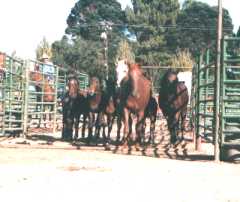
|
We recommend you look over the information presented here. Then if you are participating in the internet adoption, then click the "Go to the Adoption"
button to enter the BLM's adoption website. (For the Satellite TV adoption, please return to the Satellite TV Adoption Page.) The BLM posts rules and other information
in their website so everybody should be aware of how this process works.
|
|
WHY ADOPT WILD HORSES
AND BURROS TO THE PUBLIC?
|
|
There are literally tens of thousands of feral (wild) horses and burros roaming private, state and federal lands. These horses are all descendants of domestic horses and burros which were either intentionally turned out or escaped from early explorers, settlers, cowboys, Native Americans and even the military. Some of the horse herds have lived deep in isolated wilderness and maintain much the same characteristics of the conquistadors' Sorraia and Spanish Barb horses. Other herds are a genetic hodgepodge of horses which got together with the environment culling out all but the sturdiest members. In some cases ranchers and the early military turned out specific domestic stock to interbreed with the wild horses in order to maintain pools of "remounts" which could be gathered in and a few selected horses removed for gentling and domestic use.
A vast majority of the horse and burro herds have no natural predators, thus their populations remain unchecked except for lack of food and water. During years with good weather, the average reproduction rate for the horses is around 20%. The herds continue to grow until drought or unusually heavy snow limits available food or water becomes scarce. In such instances the weaker members of the herds start to die off, but the remaining horses can overgraze the land and disturb riparian habitats in their desperate search for food and water. To allow this to occur not only impacts future food supply for the horses but it can negatively impact some of the native animals as well.
After the advent of the automobile, there was little need for very many wild horses to be gathered to make riding mounts or work horses. When the populations of the herds reached extreme proportions, ranchers either thinned the herds by shooting or poisoning the horses or they were rounded up by "mustangers" and sold for slaughter. This practice continued until 1959, where it was outlawed due to the efforts of a Reno, Nevada secretary named Velma Johnston.
One day in the early 1950s Velma Johnston found herself following a truck which was dripping blood. She followed the truck and discovered a grisly mass of horses crammed into a trailer bound for a rendering plant. The blood was from a foal who had been crushed to death inside the truck. This discovery started Velma, later known as Wild Horse Annie on a quest to properly manage America's wild horses and protect them from inhumane treatment.
After a successful lobbying campaign, Public Law 86-234, the "Wild Horse Annie Law" was enacted which made it unlawful to poison water holes and round up horses using motor vehicles. In 1971 the Wild and Free-Roaming Horses and Burros Act" was passed unanimously by Congress which received the second largest outpouring of correspondence in history supporting the bill, many letters coming from school children.
|
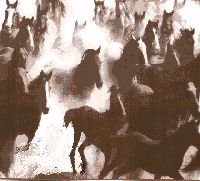
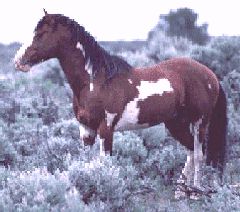
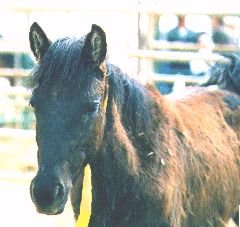
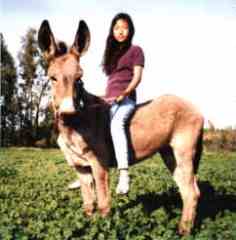
|
In order to protect the horses, the BLM internet adoption staff
can be expected to strictly enforce the adoption rules. Adopter
requirements are based on years of history in adopting animals
and are designed to protect the horse and adopter, as well as
comply with the Wild and Free-Roaming Horses and Burros Act.
All adopter applicants must:
- Be 18 years of age or older
- Have no prior violations of adoption regulations or convictions of inhumane treatment to animals.
- Not have adopted more than 3 animals in the past 12 months. Keep no more that 4 untitled animals at one
facility at any time.
- Have received title to all eligible animals previously adopted.
- Be financially able to properly house, feed, and provide veterinary and farrier care for the animal(s).
The applicant must have a proper facility or have written permission
of the owner/operator of a proper facility if the animal(s) will be kept on
someone else's property.
Facility requirements for ungentled horses include:
- An outside corral, a minimum of 400 square feet (20x20) per animal. Corral should not be too large (more
than 40x40), as animals gentle easier in smaller corrals.
- Fence must be at least 6 feet high for horses, 5 feet for burros and weanlings.
- Fencing material should be at least 5 wood rails or rounded pipes, or poles, 2x6 inch wooden planks or
similar materials that do not pose a hazard to the animal(s). Small mesh, heavy gauge, woven wire fencing
with a 2x6 inch board along the top, center and bottom is acceptable. No barb wire, no electric wire, no
T-posts.
- Once gentled, the animals may be maintained in customary horse enclosures of adequate construction and sufficient size or be pastured.
Adequate shelter must be provided
- Some sturdy form of "run-in" shelter shall be provided which can be in the form of a lounging shed, boxstall or other similar
structure for which the horse has full time access.
- If gentled horses are pastured, sufficient protection should be available from sun, wind and cold as appropriate for local climatic conditions.
- The local BLM district's Wild Horse and Burro Specialist shall make the final determination as to whether facilities and shelters meet the
intent of these requirements.
Please note that most of these animals are extremely athletic and agile, and the BLM's enclosure requirements should not be taken lightly.
The adopter will be responsible for arranging transportation from the pick-up point to the horse's place of residence. This transportation can be
provided by the adopter or the adopter can arrange for a private hauler to provide transport.
Regardless of who hauls the horse, the following trailer requirements apply.
Trailer Requirements
- Standard, covered stock trailers and horse trailers for 4 or more horses are generally acceptable,
contingent on final approval prior to loading. (Sharp edges and other dangers to a potentially
excited horse have to be appropriately padded or removed.)
- No 1-horse trailers or pickups with stock racks are permitted.
- 2 Horse trailers *may* be permitted if the center divider can be removed and the horse prevented
from jumping into the manger area. Only one horse will be loaded into a 2-horse trailer.
- All interior dividers shall be removed (including slant dividers).
- No drop ramp tailgates are allowed. They are simply too dangerous as the horse cannot be tied in
the trailer and will likely try to bolt as the ramp is lowered.
The final decisions surrounding any trailer deviations will be made by the
BLM loading crew. If you have any concerns regarding a specific trailer, we suggest you
submit photos and a description for review prior to making the trip to pick up your horse.
The BLM takes these regulations very seriously. Until these horses are adjusted to their
new surroundings, they can easily hurt themselves. We must all remember that the purpose of this
program is to help the horses, so we all need to keep the horses' well being foremost
in our minds.
To be able to participate in the on-line adoption, you must submit BLM's electronic application. This application must be complete. For viewers who are running 640x480 screen resolution, you may discover some required boxes are just out of view on the right hand side of your screen.
|
Be sure to use the proper format when filling in blanks so that it will convert correctly into BLM's data base. A common problem occurs when people enter their birthdates. The format shown in the form is xx/xx/xxxx.
This means that someone born on January 1, 1950 would fill in 01/01/1950. The months and day fields have to have 2 digits, the year has to have 4 digits and they have to be separated by "/" not "-" in order for the system to properly interpret the numbers.
Also, the Internet Adoption folks will need to get sketches and/or photographs for their records which you can mail or FAX to them. (They currently do not have the ability to take them as email attachments.) This requirement can seem a bit petty if you've had BLM horses on your property before, however we all have to realize that the internet adoption is a separate program from BLM holding facility and satellite adoptions so the Internet Adoption folks need their own original copies of supporting documentation.
You will be asked to provide a road map sketch to the property where the horse(s) will be kept. This sketch should have enough detail that someone unfamiliar with the area can find it.
You will be asked to provide a sketch of your corral and shelter layout. This should be a bird's eye view, should list dimensions (e.g., length & width), gates and overhangs should be illustrated and everything identified so that the person reviewing it can clearly understand the layout that you have.
Be sure to include your complete name and telephone number on all sketches, FAXes and email messages! The BLM is processing hundreds of these applications and it's easy for someone's work to not get matched up with their application if it is not identified. When FAXing, this information should appear somewhere in the BODY of the document as oftentimes things scrawled in the margins don't get transmitted by the FAX machines.
With all the scrutiny being placed on the internet adoption process and concerns that the process may make it easier for people to misrepresent their intent, facilities and take advantages, the Internet Adoption staff are taking compliance requirements very seriously and are even working at home on their own time in an effort to get everyone's paperwork checked and bid numbers assigned. Calling BLM personnel names because they won't bend the rules for you is not going to help your application.
|
Your map sketch should have an
orientation to "north," should
include references to principle
streets and highways and
approximate distances to
regionally known landmarks.
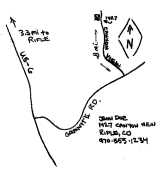
Your facility sketch should be
approximately to scale, show
the various components of your
enclosure and structures and
include linear dimensions for
fencing and awnings.
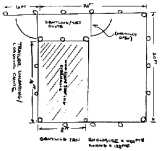
Don't forget to include your
name and phone number in the
body of your sketch or map.
|
If you get a failure message when submitting your application and it is due to an incorrect or missing entry on your application, go back to your application form, make the required corrections and resubmit it.
If you get a failure message which has nothing to do with how you filled out your application form, you need to be aware that there have been some power and telecommunications problems in the Milwaukee area and there have been some temporary outages which were beyond BLM's control. These failures may not affect the internet adoption website, but can prevent the applications from reaching the correct data server. If you encounter such problems, please wait a few hours and resubmit your application.
Don't worry if you get voice mail when you dial the 800 number. It's pretty busy but staffers check the messages regularly. (I tried it. They do.) If time is of the essence, you can call Karen Malloy's regular number, (414) 297-4412, and she'll call you back on the BLM's dime.
|
|
GETTING YOUR APPLICATION APPROVED
|
Now that you have your application submitted, the BLM may have some questions regarding issues which aren't clear to them or they may need more information. Most likely you will receive an email from Karen Malloy or one of the other staffers. If you have any questions surrounding the additional information they need, or the questions can be simply answered, you can simply reply via email. Otherwise, you should get the requested information (e.g., sketches and/or photos) together and FAX or mail it to the Internet Adoption office.
If you have general type questions please first
go to the Adoption and check their rules and Frequently Asked Questions, or you can inquire with the Wild Horse Mentors. When the Internet Adoption staff get swamped answering questions for which there are already answers posted on-line, then they fall behind in the processing of the applications. A little self discipline on the part of the participants will help keep the application and adoption process moving smoothly.
Once your application "package" is complete and approved, you will be assigned a bidder's number and password. At that point you're ready to place bids!
|
|
LOOKING AT THE HORSES
AND BIDDING
|
This is the really cool part.
Whether you're going to adopt or are just seeing what the horses are going for, it's fun to look at the BLM's offerings. On each BLM Internet Adoption page there is a "horse head button" which says "Adoption Gallery." That's where you want to go to look at the horses.
Once you are in the gallery, you'll see a button panel with lots of squares with numbers in them. If you see horses and/or burros that you like and you want to follow their progress, you can record their numbers and use this panel to go directly to them.
Below the panel will be shown the first 5 horses in the adoption. There are lots of pictures so it may take a couple of minutes for the rest of the page to load. The horses for adoption will eventually appear and they're worth looking at. Click on each picture to open up a page with more photos and details on each horse.
At the end of each series of horses is a link to the next page of horses. Also you will find a link which states
AOL Users, Click Here. Older AOL browsers can have problems viewing the adoption and this link opens up a FAQ sheet describing how to deal with it.
If the bidder for the horse is described as "BLM Opening Bid," you can open with $125 for a single horse or $250 ($125 x 2) for a mare and foal pair.
If someone has already bid on a horse, you can increase the bid by at least $5.00 over the posted high bid.
You can bid on more than one horse. If you end up high bidder on more horses than you want, you can choose the one or ones that you want and the remaining horses will be offered to the next highest bidder. Similarly if you are out bid, check the bidder's number. If it shows up high for several horses, there is a good possibility that the bidder will not take all of the horses bid on and you may be offered the horse at your highest bid offer. You will be contacted by BLM if the horse passes back to you.
Also, you have the right to see the horse in person and accept or reject it prior to being committed to taking it home. You will also need to have appropriate transportation available for your horse(s) and if you engage a commercial hauler, you will usually need to be present on loading day.
In some cases the BLM can transport your horse to a closer BLM facility if there is an agency load already scheduled which has room for your new adoptee. You will need to discuss these possibilities with Karen Malloy as the available pick up points for your adoptee may influence which horse(s) and how much you bid.
Again, don't forget to jot down the numbers of any horses that you might want to revisit on the BLM website so you can use the quick link panel to get back to them!
|
|
MENTORING AND TRAINING ASSISTANCE
|
|
This section is still being developed.
We will soon have some referrals posted for safe hauling, training and mentoring assistance.
It is not our intent to recommend any specific trainers,
but list ones which we are aware of who have BLM compliant facilities, are a reasonable haul from the adoption centers, use BLM approved methods and who have received good marks from other professionals who have reviewed their work. If you need trainer information prior to our posting this list, please email me.
The Wild Horse Mentors are volunteers who can assist you in most cases free of charge. We will also be posting a list of their locations and email addresses.
In the meantime, you can reach the Wild Horse Mentors on the "Wildhorses" list. For information about the list, please go to the
Wildhorses List FAQ Page.
|
|
This document is currently being completed by volunteers as quickly as we can. We will soon be presenting
tips for successfully applying for approval and bidding on horses offered
through the internet adoption and we will provide lists of mentors and
professional trainers who can help you get your horse off to a good start.
Please check back for additional information.
This is not a BLM operated or BLM sponsored site. It
is run by private wild horse and burro enthusiasts.
